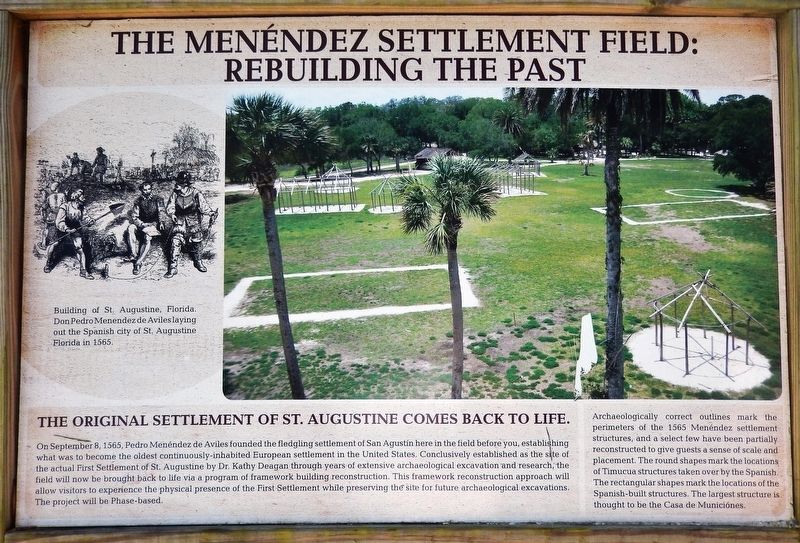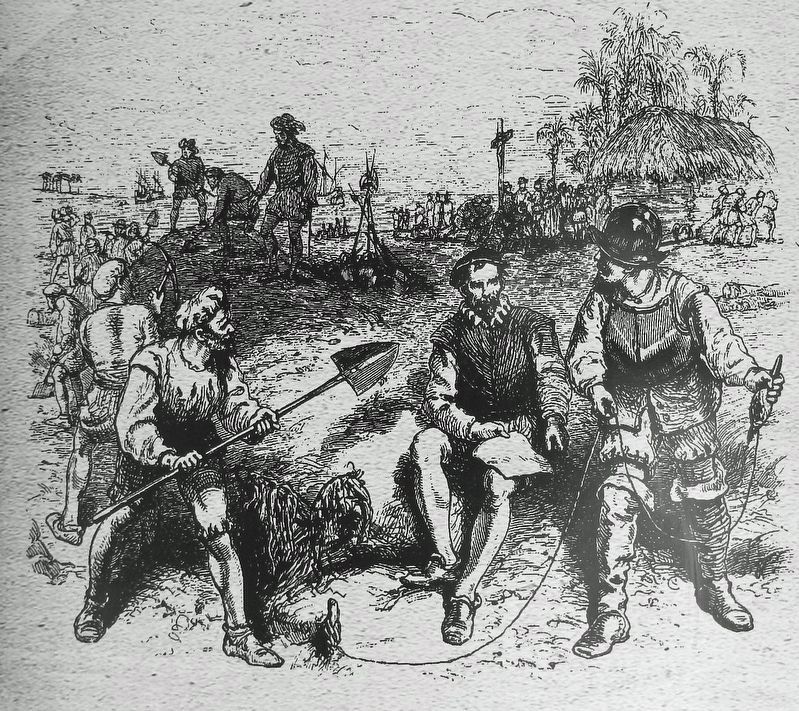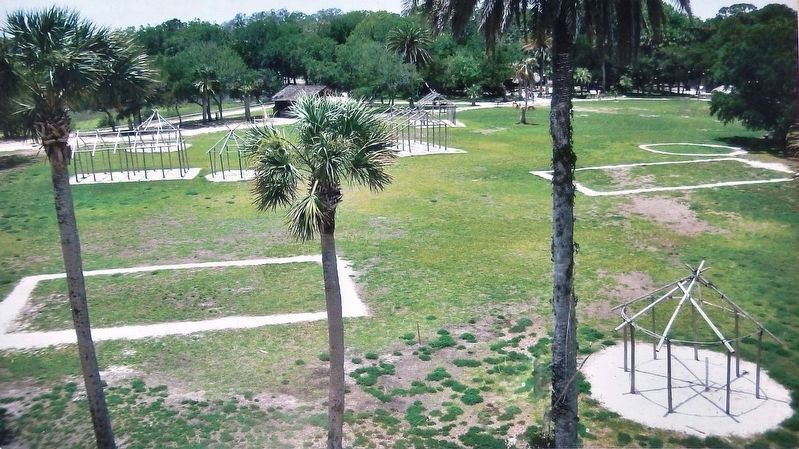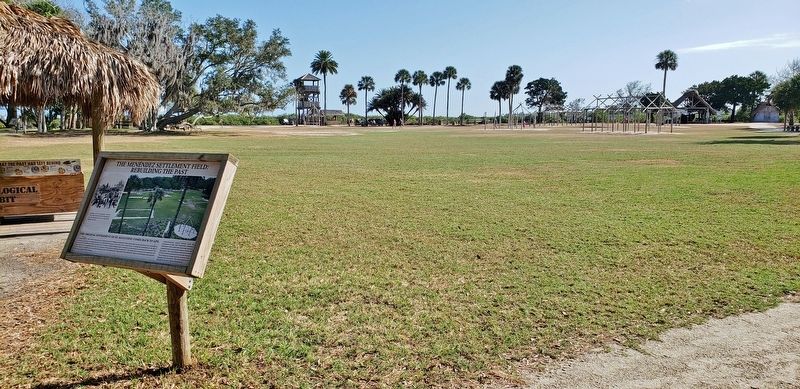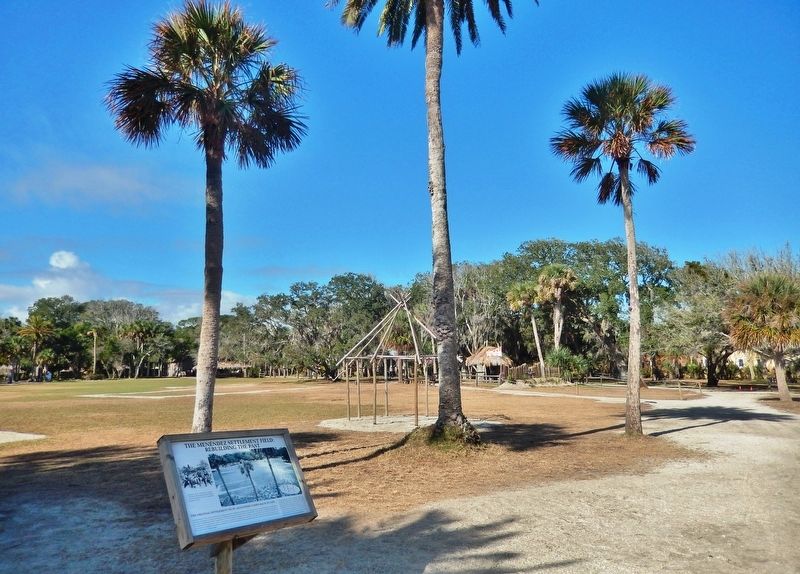St. Augustine in St. Johns County, Florida — The American South (South Atlantic)
The Menéndez Settlement Field
Rebuilding the Past
The Original Settlement of St. Augustine Comes Back to Life
On September 8, 1565, Pedro Menéndez de Aviles founded the fledgling settlement of San Agustín here in the field before you, establishing what was to become the oldest continuously inhabited European settlement in the United States. Conclusively established as the site of the actual First Settlement of St. Augustine by Dr. Kathy Deagan through years of extensive archaeological excavation and research, the field will now be brought back to life via a program of framework building reconstruction. This framework reconstruction approach will allow visitors to experience the physical presence of the First Settlement while preserving the site for future archaeological excavations. The project will be Phase-based.
Archaeologically correct outlines mark the perimeters of the 1565 Menéndez settlement structures, and a select few have been partially reconstructed to give guests a sense of scale and placement. The round shapes mark the locations of Timucua structures taken over by the Spanish. The rectangular shapes mark the locations of the Spanish-built structures. The largest structure is thought to be the Casa de Municiónes.
Topics. This historical marker is listed in these topic lists: Anthropology & Archaeology • Colonial Era • Exploration • Settlements & Settlers. A significant historical date for this entry is September 8, 1565.
Location. 29° 54.41′ N, 81° 18.893′ W. Marker is in St. Augustine, Florida, in St. Johns County. Marker can be reached from Williams Street east of Magnolia Avenue. Marker is located along the interpretive trail in Ponce de León's Fountain of Youth Archaeological Park. Touch for map. Marker is at or near this postal address: 11 Magnolia Avenue, Saint Augustine FL 32084, United States of America. Touch for directions.
Other nearby markers. At least 8 other markers are within walking distance of this marker. Archaeology of the Menéndez Encampment (here, next to this marker); The Original Mission Church (a few steps from this marker); The Owl Totem from Hontoon Island (within shouting distance of this marker); The Timucuan Home (within shouting distance of this marker); Life in the Timucuan Village (within shouting distance of this marker); Mission Life in Nombre de Dios (within shouting distance of this marker); 1770s British Anchor (within shouting distance of this marker); Timucuan Style Dugout Canoe (within shouting distance of this marker). Touch for a list and map of all markers in St. Augustine.
More about this marker. There are two identical
copies of this marker — about 100 yards apart. One is on the east side of the Menéndez Settlement Field, and the other is on the west side.
Related markers. Click here for a list of markers that are related to this marker. Ponce de León's Fountain of Youth Archaeological Park
Also see . . . North America Started on this Day in 1565.
On September 8, 1565, Pedro Menendez de Aviles landed on the shore of Seloy, a large Timucuan town that was situated just opposite what was to become St. Augustine inlet. With a fleet of seven ships and many soldiers, he was an imposing presence, and the Timucuans offered Menendez and his forces part of their village – thus establishing St. Augustine. 55 years before the Pilgrims landed at Plymouth Rock and 78 years before the founding of Jamestown, the town of St. Augustine became a keystone in Spain’s New World network of settlements.(Submitted on December 26, 2021, by Cosmos Mariner of Cape Canaveral, Florida.)
Credits. This page was last revised on December 29, 2021. It was originally submitted on December 26, 2021, by Cosmos Mariner of Cape Canaveral, Florida. This page has been viewed 208 times since then and 40 times this year. Photos: 1, 2, 3, 4, 5. submitted on December 26, 2021, by Cosmos Mariner of Cape Canaveral, Florida.
